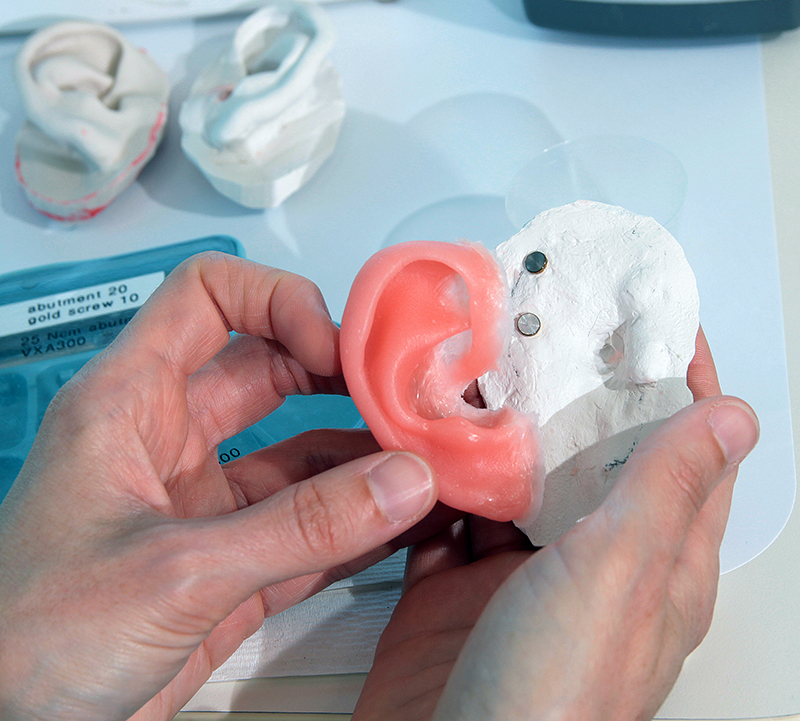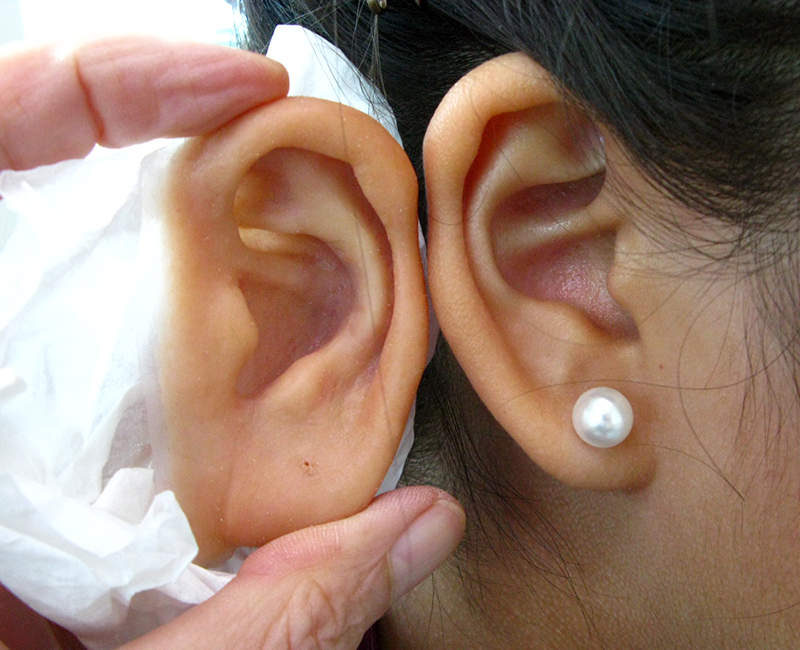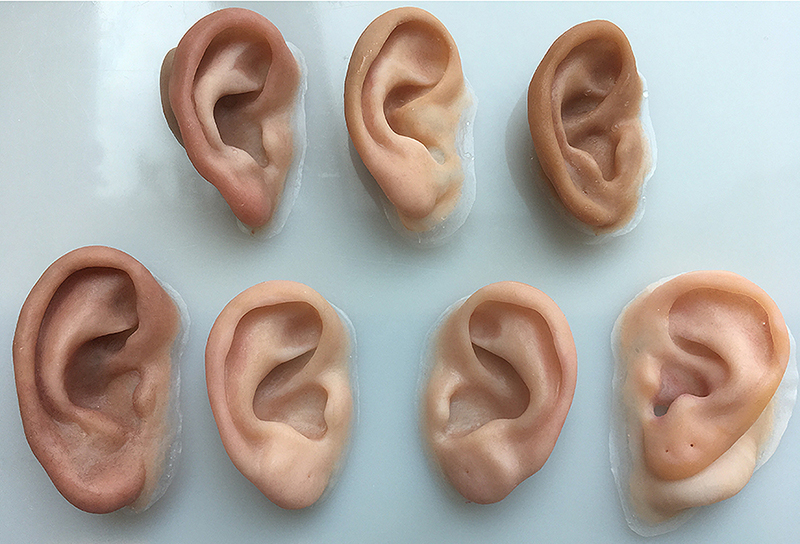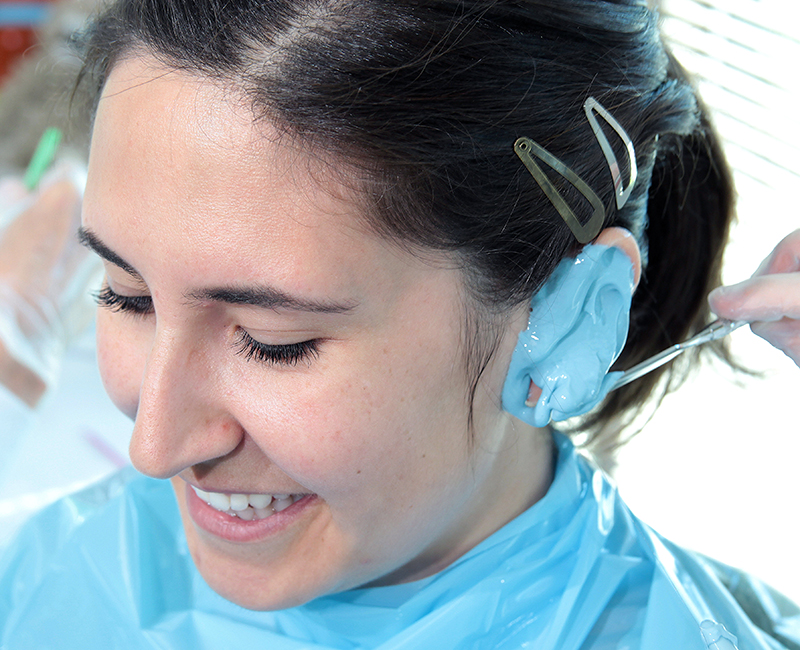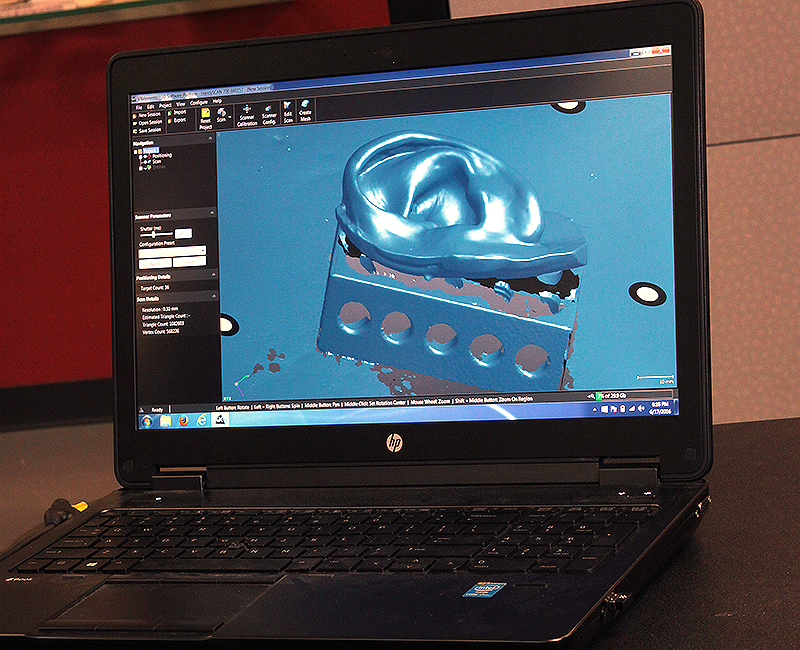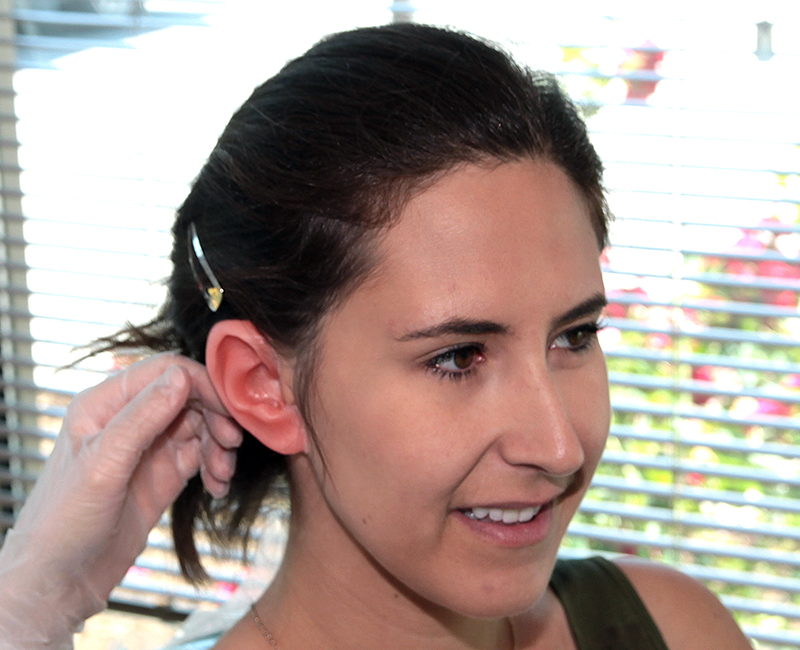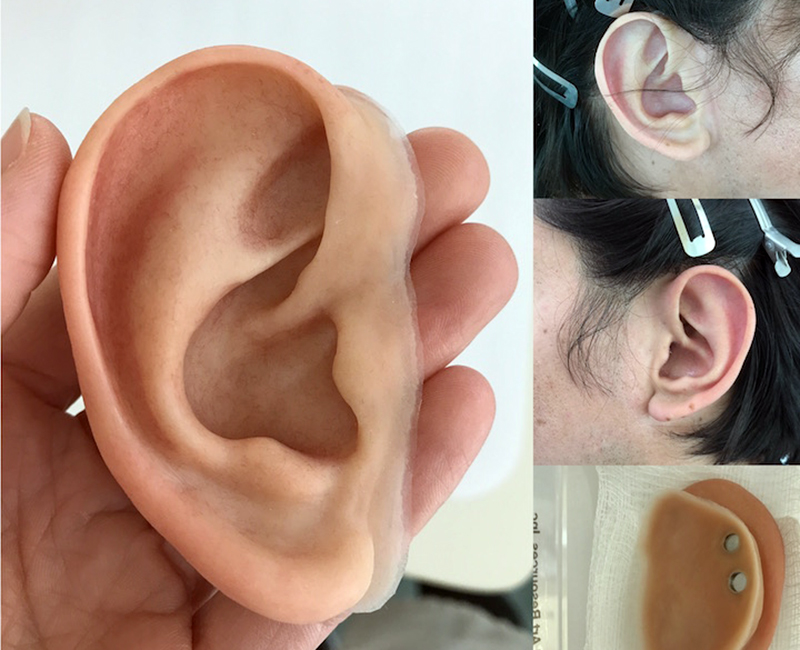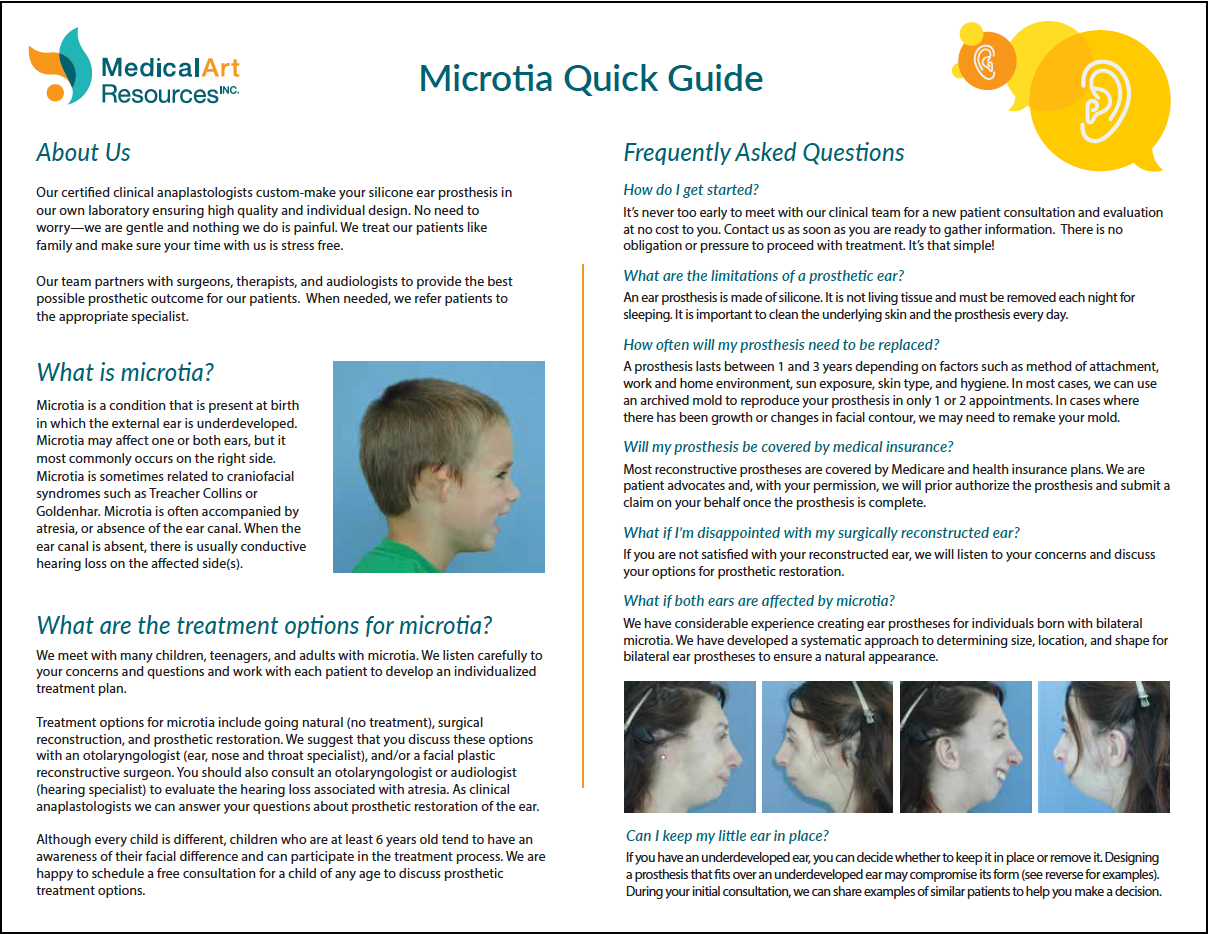Ear prosthesis
What is a Silicone Prosthetic Ear?
A silicone prosthetic ear is a reconstructive option for patients born with microtia and other birth differences such as Treacher Collins or Goldenhar syndrome; as well as those who have suffered traumatic injury or undergone cancer resection surgery (auriculectomy). Our certified anaplastologists create a remarkably life-like ear prosthesis matching the shape, skin tones, and textural detail of your healthy ear. Our patients appreciate the practically invisible transition between their skin and their realistic prosthetic ear.
Our certified anaplastologists are masters-degreed medical artists who custom-make your silicone ear prosthesis in our own laboratory ensuring high quality and individual design. No need to worry--we are gentle and nothing we do is painful. We treat our patients like family and make sure your time with us is stress free.
Interested in something else? Learn about our other services:
Prosthetic Eye Prosthetic Nose Prosthetic Fingers Prosthetic Toes Athletic Faceguard Ear Gallery
How is an ear prosthesis attached?
We work closely with you and your family to determine which method of attachment or your prosthetic ear will work best for you. Prosthetic ears can be attached in three different ways:
Medical adhesive attachment
Right ear prosthesis attached with skin adhesive
Your ear prosthesis can be attached with special medical adhesive. Most patients easily adjust to using prosthetic adhesives —much like flossing or caring for contact lenses. We offer a variety of adhesive products (a liquid adhesive or two-sided tape), so that you can choose the one that best meets your needs. Patients choose adhesive retention as a non-surgical method of ear reconstruction.
Anatomical retention– directly to the anatomy
When part of the natural ear remains, we may be able to design an ear prosthesis that fits like a glove over the ear remnant. Although some practitioners recommend removal of the ear remnant to simplify the creation of the prosthesis, we understand that many patients prefer a conservative approach. We use techniques developed in our lab that allow us to overlap an intact portion of the ear to secure a prosthetic ear with little or no skin adhesive.
Craniofacial bone anchored implants
Craniofacial bone anchored implants are small titanium fixtures that are surgically implanted during an outpatient surgical procedure to attach your prosthetic ear. These implants bond with bone (osseointegrate) to provide a stable foundation for your ear prosthesis. The surrounding bone bonds with the implants during a 3-6 month healing period. Once the healing period is complete, you can snap the ear prosthesis onto the implants using clips or Technovent magnets; you can attach and remove the prosthesis with ease.
Medical Art Resources was the first practice in Wisconsin to partner with surgeons at Children’s Hospital of Wisconsin and University of Wisconsin Hospital to create implant-retained ear prostheses. If you choose bone anchored (osseointegrated) implant attachment, we can work with your surgeon or recommend a surgeon close to where you live who is experienced with the Southern Implants implant system. Together with your surgeon we identify the ideal location for 2 or 3 implants to assure the best possible prosthetic outcome for you.
Technovent magnets attached to Vistafix implants for secure attachment of an ear prosthesis
Am I a candidate for implants?
You should discuss with your surgeon if you are a candidate for implants as well as what the potential risks and complications of the procedure might be. Patients who have been treated with radiation therapy may require a longer healing period as well as hyperbaric oxygen treatment to decrease risk of implant loss.
About Microtia and Prosthetic Reconstruction
Microtia describes a malformed or underdeveloped external ear
Click here to download or print our Microtia Reference Guide PDF.
Microtia: some things to think about
For surgical ear reconstruction or prosthetic ear restoration, we suggest that you discuss these options with an otolaryngologist (ear, nose and throat specialist), and/or a facial plastic reconstructive surgeon. You can also consult an otolaryngologist or audiologist (hearing specialist) to evaluate the hearing loss associated with atresia (absence of the ear canal). As clinical anaplastologists we can answer your questions about the benefits and drawbacks of prosthetic restoration of the ear.
Right ear prosthesis worn over an underdeveloped ear—no surgery required
If you have an underdeveloped ear, you can decide whether or not to keep it in place. One consideration is that by maintaining the underdeveloped ear you may preserve tissue that could be valuable for future surgical reconstruction. However, designing a prosthesis that fits over an underdeveloped ear may compromise its form. During your initial consultation, we can share with you examples of similar patients to help you make a decision.
If both ears are affected
When both ears are missing, bilateral (left and right) ear prostheses are designed systematically to ensure a natural appearance
Medical Art Resources has considerable experience creating natural looking ear prosthetics for individuals born with bilateral microtia (both ears underdeveloped). We have developed a systematic approach to determine the appropriate size, location and shape for bilateral prosthetic ears to ensure a natural appearance. We shared our unique approach with other professionals at the Third International Symposium on Bone Conduction Hearing and Craniofacial Osseointegration in Sarasota, Florida.
Connect with experts who care!
If you are considering an ear prosthesis, we welcome you to meet with us for a new patient consultation and evaluation at no cost to you.
You will meet with one of our clinical anaplastologists who will listen to your concerns, examine your affected anatomy, and show you examples of ear prosthetics. Our anaplastologist will describe your options for prosthetic attachment and will develop a treatment plan for you. Be assured our clinical staff have earned masters degrees from accredited institutions and are certified in their specialty.
If you are unable to meet with us in person in Milwaukee or Madison, Wisconsin or one of our satellite locations, we can schedule a brief evaluation via Facetime or Skype. If you are not comfortable with a video meeting, you can provide us with photos and schedule a phone meeting.
Please contact us to schedule your complimentary initial consultation and evaluation. There is no obligation or pressure to proceed with treatment.
HOW DO WE MAKE AN EAR PROSTHESIS?
The process requires 3 to 5 appointments which involve these steps:
Make molds of your ear region using gentle materials.
We sculpt by hand or scan, mirror-image and 3-D print a model that we then convert to wax.
Have you try on the wax ear model to ensure a natural contour and fit.
Formulate 5 or more colors to match your unique skin-tones using health grade silicone.
Pigment is mixed directly into the silicone to achieve a durable color match
Make a durable mold which allows us to reproduce the prosthetic ear when the sculpture is finalized.
Meticulously paint every skin detail using your color formulae in your mold.
Intrinsic coloration process for an ear prosthesis
Delicately paint color details, such as freckling, onto the surface.
Check the ear prosthetic for precise fit.
We demonstrate wear and care instructions so that you can use your silicone ear prosthesis with confidence.
CHILDREN WITH MICROTIA
If you have a child with a birth difference you will likely have many decisions to make. Our website should help answer common questions about prosthetic ears, but feel free to contact us to discuss your individual needs and schedule an initial consultation. Resources such as Ear Community provide excellent information for families with questions about microtia.
Although every child is different, children who are at least 6 years old tend to be aware of their facial difference and can participate in the treatment process. We are happy to schedule an initial no cost consultation for a child of any age to discuss prosthetic treatment options. There is no obligation or pressure to proceed with treatment.
TEENS AND ADULTS WITH MICROTIA
Ear prosthesis attached with magnets to bone anchored Vistafix implants
We meet many teens and adults of all ages who have not had surgical or prosthetic treatment and want to explore the benefits and drawbacks of ear prosthetics.
NOT SATISFIED WITH YOUR EAR RECONSTRUCTION?
We also meet with patients who are disappointed with their surgical ear reconstruction or prosthetic restoration. If you are not satisfied with your existing prosthesis, we will listen to your concerns and discuss your options honestly. There is no obligation or pressure to proceed with treatment.
Ear prosthesis after removal of ear reconstruction
INSURANCE COVERAGE
If you decide to proceed with your prosthetic treatment plan we will ask you to provide us with insurance or other payer information. With your permission we will request a physician’s order and clinical notes from your doctor. This information will help us predetermine your insurance benefits and submit a prior authorization request. We strive to set fees that are affordable, including reduced fees for replacement ear prostheses. We accept many health insurance options. Please be assured that we will help you navigate the complexity of billing for medical care. We also advocate on behalf of patients for coverage of reconstructive ear prosthetics with insurance providers.
WANT TO KNOW MORE? VISIT FAQS
BEHIND THE SCENES - MAKING AN EAR
Learn more in a brief video about our process for making an ear prosthesis:
“Glad we went to the magnets! This ear stays on better, looks great, fits so well I don’t even notice it is on. Thank you Julie and Megan for improving my daily life.
Fitting into daily life is a huge deal for anyone wearing a prosthetic.”




